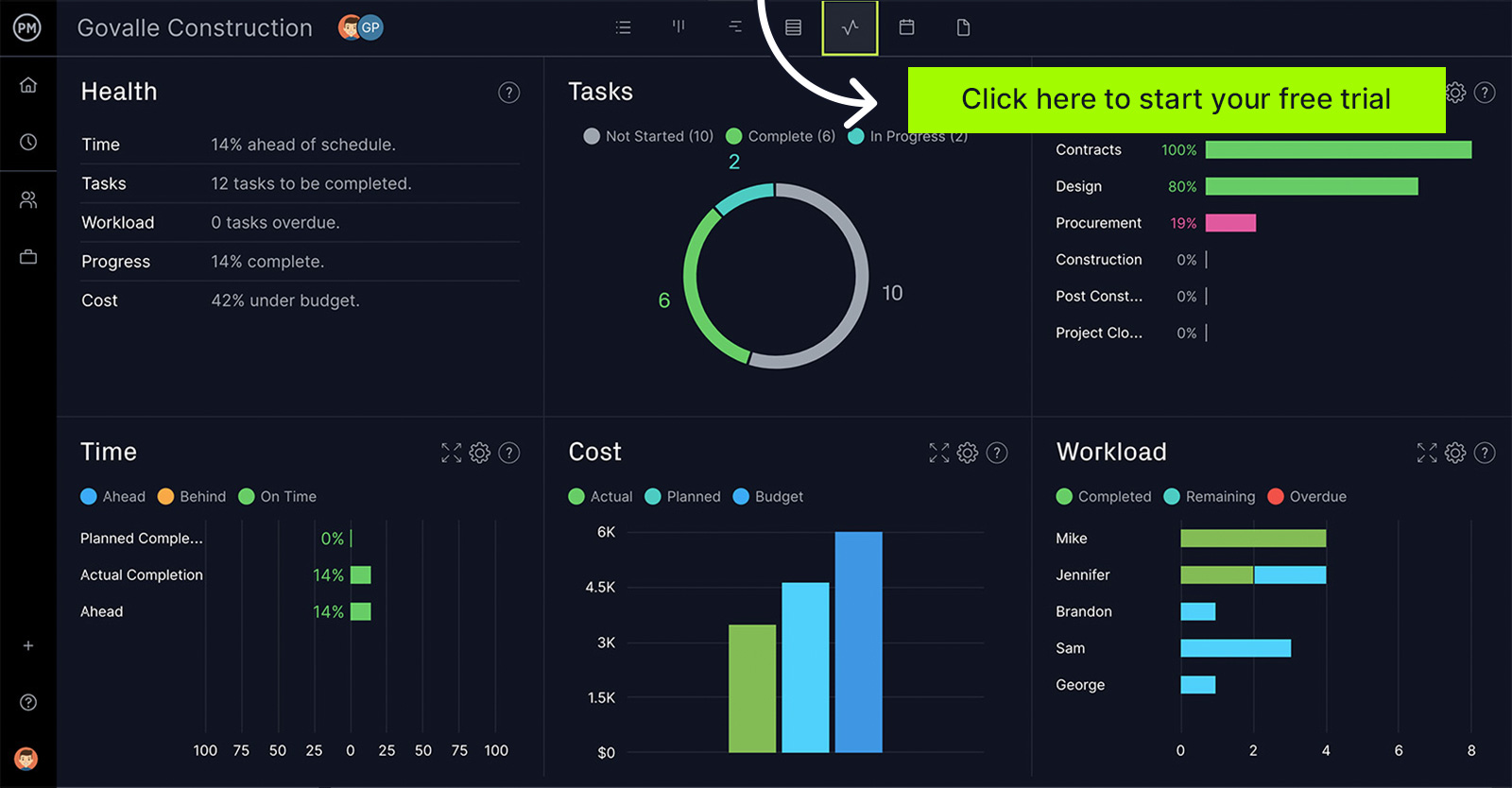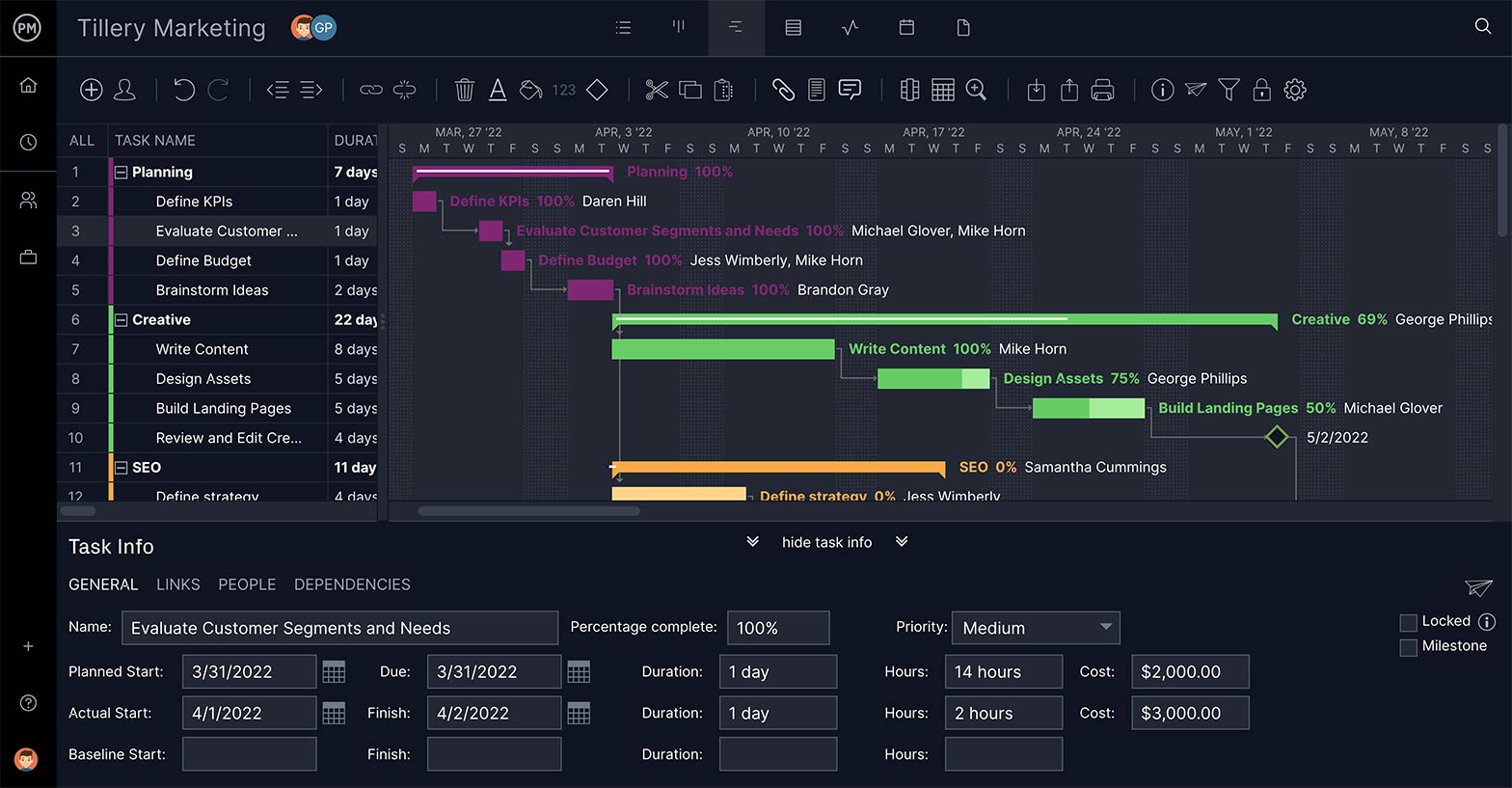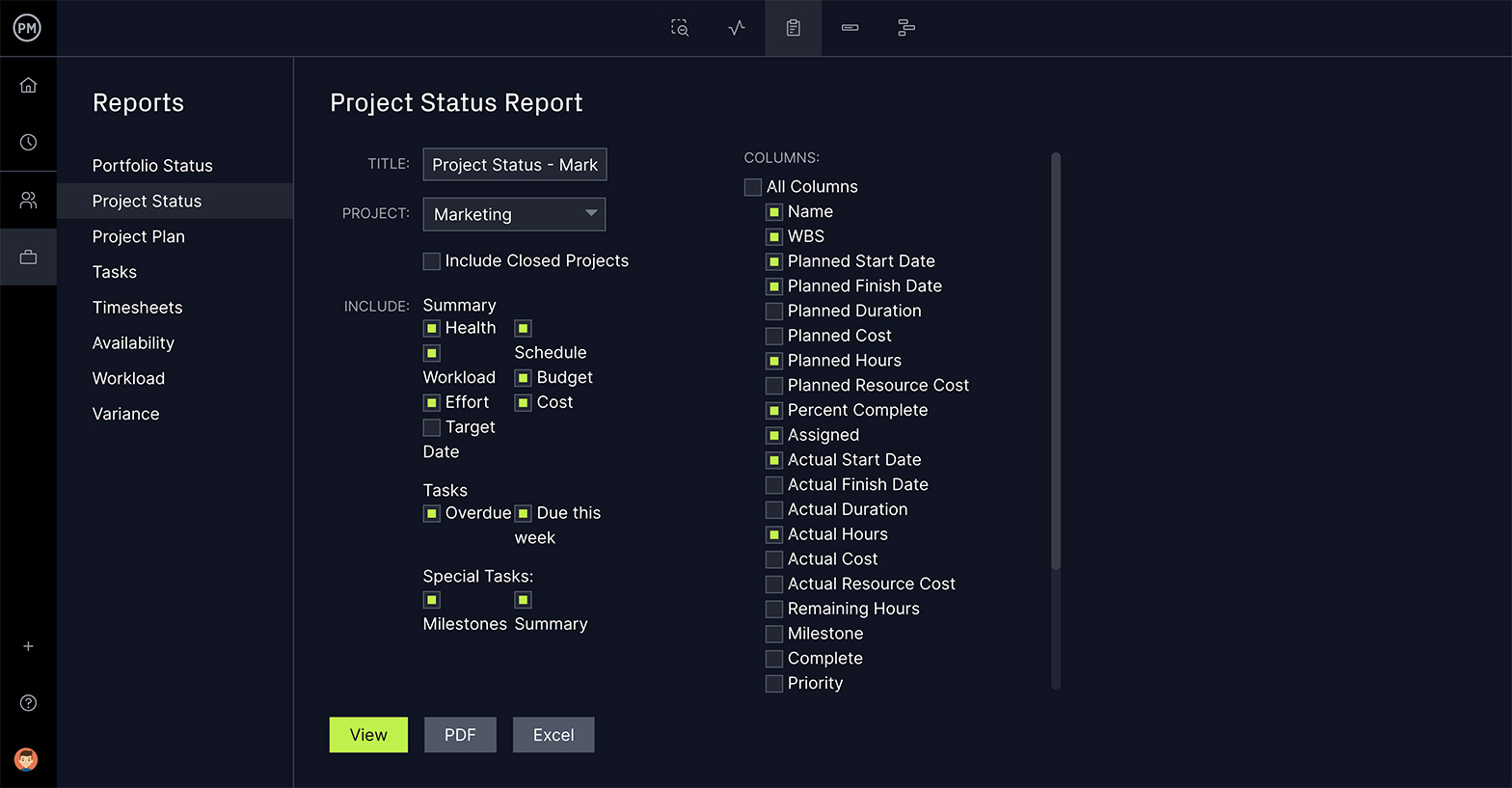Whether you’re a numbers person or not, as a project manager, ownership of a budget is usually a key part of your job responsibilities. Creating and managing a project budget can be a daunting task, but it can be easy if you use the right project budgeting software.
Projects can have several different types of costs that all need tracking in order to ensure that everything comes in under budget. All of those moving parts and fluctuating costs can be better tracked with an online project management software like ProjectManager.
We offer you tools that simplify project budgeting and cost management, enabling you to set a baseline, track labor rates and add new costs on a task level. With these features, you can simply update and add items as they arise throughout the project.
ProjectManager is cloud-based software that allows you to plan and track project costs in real time. You have the tools to build an accurate budget and set a baseline to monitor project costs and resource rates with our real-time dashboard. Get more control, data and visibility for your project and budget. Get started with ProjectManager today for free. Now, before we learn how to use project budgeting software, let’s define a project budget.

What Is a Project Budget?
A project budget is how project managers estimate the cost of completing a project. This includes every phase in the project and each of the many tasks that make up those project phases. The accuracy of the budget forecast is critical to delivering success and making sure your project is approved and funded when needed.
Another aspect of the project budget is monitoring costs as you execute your tasks. Without a clear window into your expenditures, it is easy for costs to get out of hand. This is a complicated process but one that is improved with the use of project budgeting software.
This tool needs to show real-time data, however, in order to track costs as they happen to give project managers time to make adjustments as needed to keep to your budget. Let’s take a moment to look at the importance of using project budgeting software.
Why Should You Use Project Budgeting Software?
Project budgeting software is an essential tool for creating an accurate budget and then tracking costs as you go through the life cycle of the project. It allows you to plan budgets and control them by tracking expenditures. Therefore, they assist project managers through the entire budgeting process.
Not only that, but using project budgeting software gives stakeholders, executives and managers access to the budget and how it is being spent over the course of the project. You can budget your project with spreadsheets, but they are cumbersome and static documents that are hard to update.
Most project budgeting software is online and updates as your team update their statuses. This provides managers with real-time data that allows them to make more insightful decisions as they manage the project budget. When you’re making and managing a project budget you live and die by the accuracy of your numbers. Project budget software keeps you on top of what you’re spending to bring in your project without going over the budget.
How to Create a Project Budget in 3 Steps
The key to creating a project budget is to make all the line items easy to track. If you can apply a straightforward process to project expenses, then you can monitor the spending on a project accurately and timely.
Follow these simple steps for building a project budget that will set you up for success.
Identify Expenses
The first step in creating a budget is to identify expenses. You need to list every single thing that’s required to bring a project completion. This includes wages for labor, equipment, materials and more. You’ll want to examine your project plan thoroughly and identify expenses on your own to start.
Then, your team members might be able to help you recognize certain expenses that you didn’t recognize immediately, so be sure to ask them to look over your expense list when creating a budget. It’s imperative that you list absolutely every expense. The more you identify, the less you’ll be surprised by unforeseen expenditures later in the project.
Estimate All Costs
Now estimate every item on your list. If your list is in ProjectManager, you can add your estimate to the line item immediately. There are a number of strategies that you can use to do make your estimates. The most common estimating techniques are:
Bottom-Up Estimating: Start with the components of each task and then add them up
Expert Judgement: Ask experts on your team to work out the cost of a task
Analogous Estimating: Use past experience to judge how much the project tasks will cost this time.
Add up all of the estimates. This gives you the total planned budget for the project covering the cost of every task. Our estimate template can help you do that.
Add in the Extras
Extras? What extras? Well, the cost of each individual task isn’t going to be enough, unfortunately. You still might want to add:
- Management Reserves: This is a pot of money to use at management’s discretion.
- Contingency: Contingency costs are useful to cover unforeseen costs due to poor estimating. It’s common practice to add in a contingency of 10% just in case the estimates turn out to be inaccurate.
- Risk Response Budget: If your company is mature at managing project risk, you might be able to incorporate the risk response budget separately from your main budget. The risk response budget includes funding to implement any risk-mitigating actions.
How to Manage a Project Budget with ProjectManager
Now that you’ve established a project budget and identified expenses, you can enter that information in ProjectManager, if you haven’t already. To enter your project budget, simply click on the “Info” tab and enter a figure into the box.
ProjectManager offers different avenues to add project expenses. First, you can go into the expenses tab and add fixed expenses that don’t have hourly rates or fluctuations. For example, you can enter the cost of the material necessary for your project. You can choose to add this as a planned cost at first, and then you can go in later and add another expense as the “actual cost.” This will help you track planned vs actual costs in your dashboard as the project unfolds.

Another way to enter expenses into the project is via our resource management tools. Assign your resources or workforce, hourly rates, then assign them tasks, and as they work their labor cost will be automatically added to the project. You can also add expenses on the task level. Let’s say an unexpected task comes up that wasn’t in your initial plan. That’s OK because you can use your contingency money to cover it. Just add a cost amount to your new task in your project plan, and that new cost will be reflected in your dashboard and reports.
Monitor Expenses Across the Entire Project
Once you’ve identified and recorded the expenses, you have to monitor the actual expenditures compared to the estimates. That means you need to constantly update your project expenses with the amounts you actually spend on the tasks.

Since you’ve entered all of your planned expenses into the system, you can use our real-time dashboards to track actual vs planned costs. Our project dashboards offer one clear window into the ongoing costs of the project and feature easy-to-read, colorful bar graphs for quick analysis of where your budget stands. This instant view can be vital when managing a project budget, especially a tight one.
Report on Expenses Down to the Task Level
Without the right tools, project reporting can be a hassle. And by the time you finally produce the report, the numbers have changed and your report is already obsolete. ProjectManager can help. Our software can create instant, detailed reports that you can share with relevant people across the organization in the format they prefer.

There are a number of reports you can make, but the expenses report will be the most crucial for managing your budget. With an expenses report, you can get an in-depth analysis of the total budget, actual expenses and planned expenses, all the way down to the task level.
Revise Your Initial Estimates
Finally, you’ll want to go back to these reports and make sure they’re on track with your project schedule. If they’re not aligning to your time frame then you need to look back at your expenses and double-check that you’ve included everything and not left anything out.
That brings us to our last step: revise. You may have to revise the estimates and budget proposals you made earlier. Don’t get stuck on keeping them if the project dictates something else. By revising in real time you are making sure that the budget isn’t just numbers on a spreadsheet but an accurate expense forecast for the project.
ProjectManager Has Everything You Need for Budget Management
When you consider that you can track your budget with real-time dashboards, input recurring expenses like labor costs, and report on every aspect of the project, it’s clear that ProjectManager has what you need to create and manage a project expenses. Complete your next project under budget with this free 30-day trial of our PM software.
ProjectManager is award-winning work and project management software that plans, monitors and reports on projects. Get real-time data to manage budgets better. Share reports with stakeholders to keep them updated and manage their expectations. Join the teams at NASA, Siemens and Nestles who are already managing their project budgets successfully with our tool. Get started with ProjectManager for free today.

